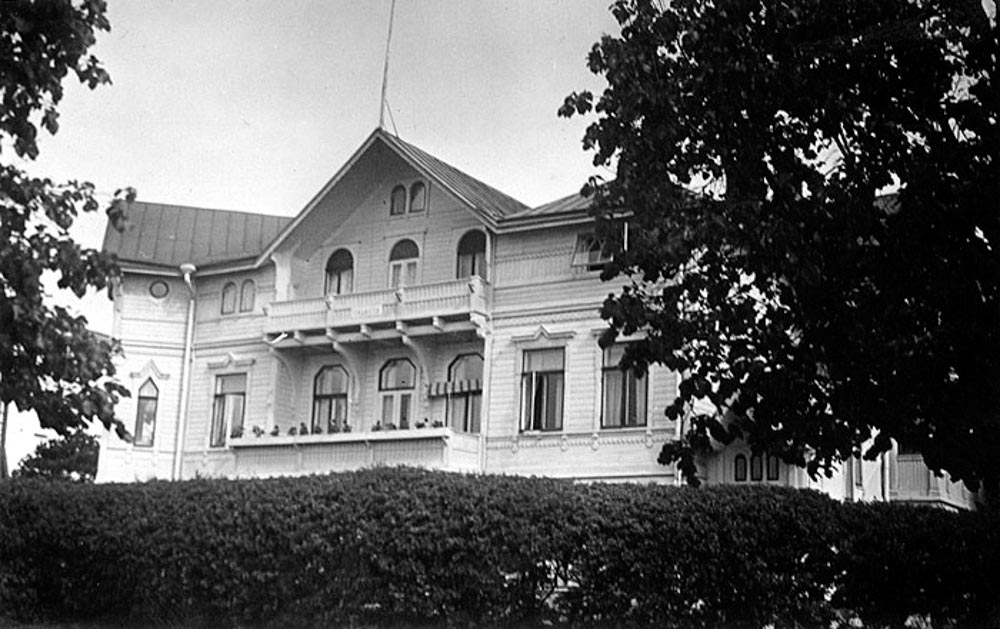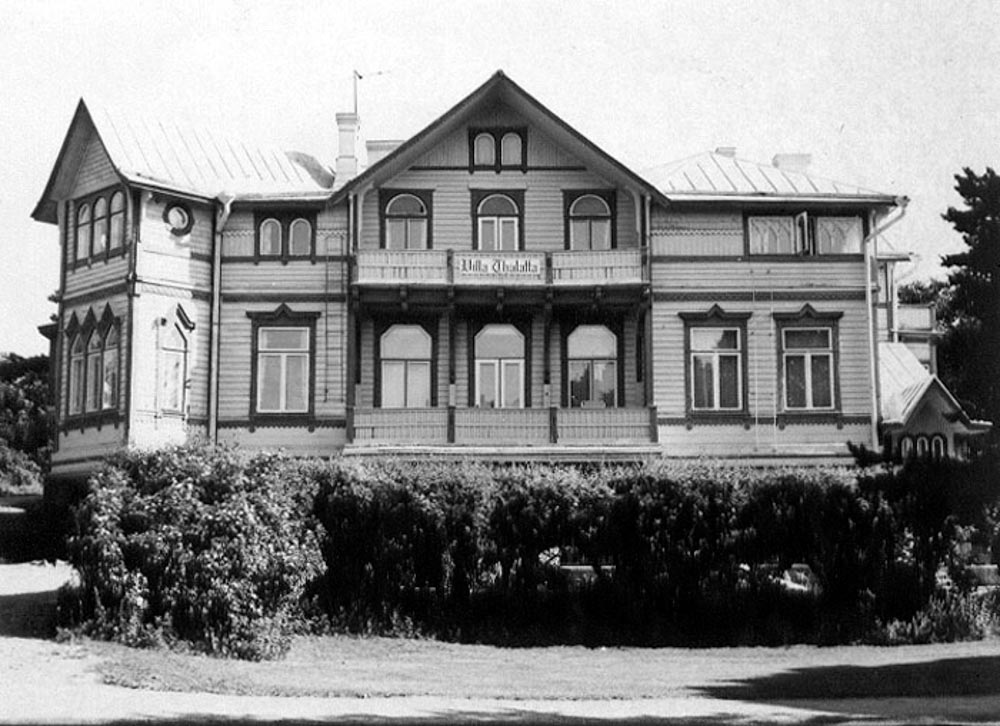
Thalatta! Thalatta! Greek warriors shouted for joy this word for the sea 400 years before the end of time. The poorly run military expedition turned into a relief when they saw the homely shores of the Black Sea. A couple of thousand years later, even in Hanko you can shout for joy Thalatta! Then you will say hello to a wonderful wooden villa on the southern slope of Vartiovuori right by the sea.
Text: Ilkka Rautio
Villa Thalattan suunnitteli arkkitehti Bruno F. Granholm vuosina 1893-94. Granholm tunnetaan myös Helsingin ravintola Kappelin lasipaviljonkien suunnittelijana. Huvilan rakennutti rautatieinsinööri Ferdinand von Christierson. Ferdinand opiskeli Hannoverissa ja työskenteli Saksassa, Venäjällä ja Englannissa. Kun Hanko-Hyvinkää junarata valmistui 1873, palasi hän Suomeen. Hän kihlasi tulevan vaimonsa Olga Appelgrenin 1875, ja vuonna 1882 hän aloitti työt höyrylaivojen tarkastajana Hangossa. Ferdinand oli aktiivinen Hangon kehittäjä ja hän toimi useissa kaupungin luottamustehtävissä. Eläkkeelle tarkastajan toimesta hän jäi vuonna 1921 yli kahdeksankymmentä vuotiaana. Thalatan ja meren välissä kulkeva tie on nimetty von Christiersonin mukaan.
Tyyliltään Thalattassa on yhdistelty sveitsiläistyyliä, joka edustaa puulle luontaisia työmenetelmiä, koristeelliseen nikkarityyliin. Molemmat tyylit olivat muodissa 1800-luvun jälkipuoliskolla. Huvilan julkisivujen paanuvuoraus puolestaan ammentaa muinaispohjoismaisesta tyylistä.
Thalatta toimi huvilana mutta sieltä pystyi vuokraamaan huoneita ainakin 1910-luvulla. Rautatieinsinööri von Christierson myi huvilan filosofina tunnetulle professori Rolf Lagerborgille. Hänet tunnettiin kiivaana ajattelijana. Esimerkiksi Lagerborgin vuonna 1902 kirjoittama näytelmä Öfver bräddarna (yli lautojen) sai ensiesityksensä vasta vuonna 2014, koska näytelmää pidettiin aikanaan liian radikaalina. Rolf Lagerborgin serkku arkkitehti Signe Lagerborg-Stenius uudisti vuonna 1916 Thalatan julkisivua sekä paransi talotekniikkaa. Signe Lagerborg-Stenius suunnitteli Hangossa myös muita rakennuksia. Hänen kynästään on mm. Ljungbon keuhkoparantalo, jonka hän suunnitteli serkulleen lääkäri Viva Lagerborgille – Rolf Lagerborgin siskolle. Huvilassa vieraili myös monia merkkihenkilöitä, ja tiedetään erään Mannerheiminkin viettäneen kesiään talossa.
Vuonna 1927 saapui Hankoon 42-vuotias neiti Hilja Siviä Pastell New Yorkista. Hän oli lähtenyt Amerikkaan paremman elämän toivossa ja palasi nyt Suomeen mukanaan matkalaukullinen rahaa. Näillä rahoilla hän osti Villa Thalatan ja alkoi pyörittämään majoitustoimintaa. Neiti Pastell tunnettiin omalaatuisena henkilönä ja hän oli tuttu näky Hangon katukuvassa.
Toisen maailmansodan aikana villa Thalatta toimi sairaalana sekä upseerien majoituspaikkana. Ehkä aamuvarhain 1.12.1939 merivoimien komentaja jääkärikenraali Väinö Valve oli tähystämässä merelle Thalatan parvekkeelta kun Puna-armeijan laivat lähestyivät Hankoa? Onneksi Valveen komennossa ollut Russarön rannikkotykistö onnistui torjumaan hyökkäyksen. Tästä muistona Thalatan yläkerrassa sijaitseva kenraalisviitti on nimetty kenraali Valveen mukaan.
Villa Thalatta sekä viereinen huvila Villa Tellina sai uudet omistajat vuonna 1954 kun Matti ja Anna-Liisa Haahti aloittivat majoitustoiminnan Hangossa. Heidän jälkeensä majoitustoimintaa pyörittää jo Haahtien neljäs sukupolvi. Christian ja Mira Haahti sekä heidän poikansa Edwin tarjoavat matkailijoille mahdollisuuden kokea entisajan tunnelmaa upeissa puuhuviloissa meren äärellä. Ehkä Thalattan parvekkeelta voi kesäyössä kuulla ilon huudahduksen Thalatta! Thalatta!
Sources:
Lehto, Tiina: Hanko's building culture and cultural landscape. Hanko Museum Publication Series No. 8. Hanko 1989.
Aho, Jouko: Lagerborg, Rolf (1874–1959). Kansallisbiografia-verkkojulkaisu. 24.2.2000. Helsinki: Suomalaisen Kirjallisuuden Seura.
Photos: Hanko Museum,



